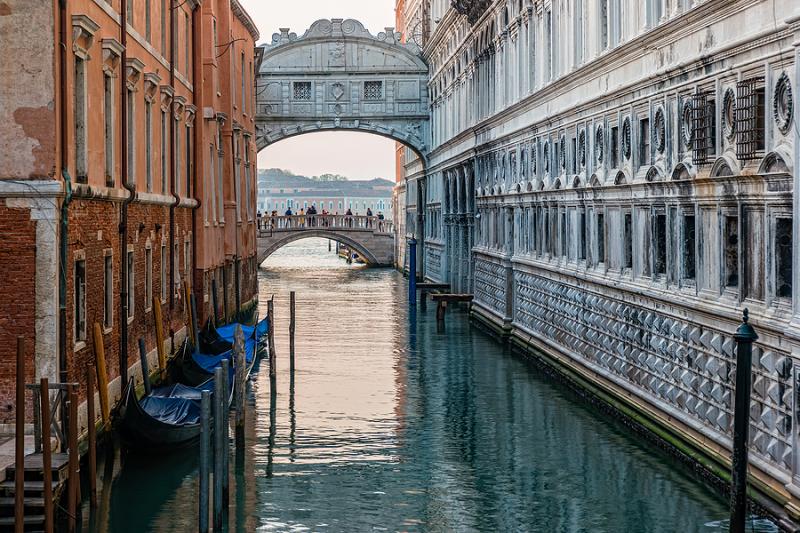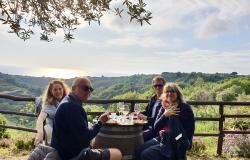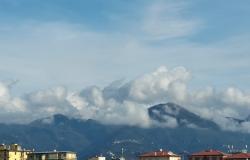Wonders of Italy: The Bridge of Sighs
ITA:

Use player to listen to Italian version
For our Dual Language series, we begin a journey through Italy’s landmarks, famous and less famous, most visited and hidden gems, monuments and museums, archeological sites and natural wonders - one for each week of the year ahead, so that you can either revisit a place in your memory or make an inspired list of all the Italian sites you wish to see.
May 2021 be full of travel, wonder and discoveries.
Ponte dei Sospiri, Venezia
Anyone who’s visited Venice has probably taken a photograph with the Bridge of Sighs in the background; it is, after all, one of the city’s most famous sights. Or perhaps you’ve passed under it during a gondola ride!
Whether you’ve seen it in person or not, it is one of those iconic sights of Italy, like the Colosseum in Rome or the Duomo of Florence. But how much do you know about its history? And did you know you can actually visit the bridge inside?
A brief history of the Bridge of Sighs in Venice
For many tourists, the Bridge of Sighs is considered an idyllic spot, perfect as the background for a romantic couple’s photo. In reality, the ‘sighs’ have nothing to do with love.
The bridge was built in 1614 to connect the Magistrates’ Rooms inside the Doge’s Palace with the New Prisons, after a fire severely damaged the Palace, which, among other things, housed the old prisons. The two structures were adjacent, but separated by the Rio di Palazzo canal, hence the need for a bridge.
This covered walkway, Baroque in style and built in beautiful Istrian stone, allowed convicts to reach the prisons directly from the courthouse halls. It features a series of small windows overlooking the lagoon and the island of San Giorgio in the distance. It is said that, upon seeing such a beautiful view, the convicts would sigh, aware they were about to lose their freedom. A sigh of despair then, not of romance!
The Bridge of Sighs can be best admired from the Ponte della Paglia, which crosses the Rio Palazzo canal at the point where it enters the lagoon. It is reached walking along the Riva degli Schiavoni, the waterfront promenade beginning at St. Mark’s Square. You can also view the Bridge from the Ponte della Canonica, on the other side in relation to the Ponte della Paglia. It is located in the Sestiere San Marco, behind the Piazzetta dei Leoncini.
Visiting the Bridge of Sighs in Venice
Besides the classic photo op from the outside, it may be more thrilling to actually walk on the bridge itself, as the convicts did. In order to do this, you have to book the regular visit of the Doge’s Palace (currently closed due to Covid). This tour includes visits to several rooms of the Palace, including the new prisons and the rooms of the Doge's Apartment.
You can also visit the Doge’s Palace virtually at this link: https://artsandculture.google.com/partner/palazzo-ducale.
Per la nostra rubrica dedicata agli articoli in italiano e inglese, iniziamo un viaggio attraverso i monumenti italiani, famosi e meno famosi, i più visitati e le perle nascoste, opere e musei, siti archeologici e meraviglie naturali - uno per ogni settimana dell'anno a venire, in modo che tu possa rivisitare un luogo nei tuoi ricordi o trarre ispirazione per una lista di tutti i siti italiani che desideri vedere.
Che il 2021 sia ricco di viaggi, meraviglie e scoperte.
Ponte dei Sospiri, Venezia
Chiunque abbia visitato Venezia ha probabilmente scattato una fotografia con il Ponte dei Sospiri sullo sfondo; è, dopo tutto, uno dei luoghi più famosi della città. O magari ci sei pure passato sotto durante un giro in gondola!
Che tu l'abbia visto di persona o no, il Ponte dei Sospiri è uno di quei luoghi iconici d'Italia, come il Colosseo a Roma o il Duomo di Firenze. Ma quanto ne sai della sua storia? E sapevi che puoi visitare il ponte all'interno?
Breve storia del Ponte dei Sospiri a Venezia
Per molti turisti, il Ponte dei Sospiri è considerato un luogo idilliaco, perfetto come sfondo per una foto romantica di coppia. In realtà, i ‘sospiri’ non hanno niente a che fare con l'amore.
Il ponte fu realizzato nel 1614 per collegare le Sale dei Magistrati all'interno di Palazzo Ducale con le Nuove Carceri, dopo che un incendio danneggiò gravemente il Palazzo, che, tra le altre cose, ospitava le antiche carceri. Le due strutture erano adiacenti, ma separate dal canale Rio di Palazzo, da qui la necessità di un ponte.
Questo passaggio coperto, in stile barocco e costruito in bella pietra d'Istria, permetteva ai condannati di raggiungere le prigioni direttamente dalle sale del tribunale. Presenta una serie di piccole finestre che si affacciano sulla laguna e sull'Isola di San Giorgio in lontananza. Si dice che, vedendo un panorama così bello, i detenuti sospirassero, consapevoli di essere vicini a perdere la libertà. Un sospiro di disperazione dunque, non di romanticismo!
Il Ponte dei Sospiri può essere ammirato al meglio dal Ponte della Paglia, che attraversa il canale Rio Palazzo nel punto in cui questo si immette nella laguna. Si raggiunge percorrendo la Riva degli Schiavoni, la camminata vista mare che parte da Piazza San Marco. È inoltre possibile vedere il Ponte dei Sospiri dal Ponte della Canonica, dall'altra parte rispetto al Ponte della Paglia. Si trova nel Sestiere San Marco, dietro la Piazzetta dei Leoncini.
Visitare il Ponte dei Sospiri a Venezia
Oltre alla classica foto dall'esterno, potrebbe essere più emozionante camminare sul ponte stesso, come facevano i detenuti. Per fare questo è necessario prenotare la visita all'interno di Palazzo Ducale. Questo percorso prevede la visita a diverse stanze del Palazzo, comprese le nuove prigioni e le stanze dell'Appartamento Ducale.
Puoi anche visitare Palazzo Ducale virtualmente a questo link: https://artsandculture.google.com/partner/palazzo-ducale.











